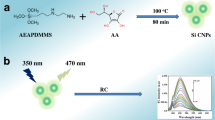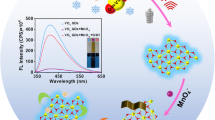Abstract
The authors describe a fluorometric method for the turn-on determination of vitamin C (ascorbic acid). The blue fluorescence of silicon nanoparticles (SiNPs; with excitation/emission maxima at 350/450 nm) is found to be quenched by CoOOH nanoparticles (NPs). In the presence of vitamin C, the CoOOH NPs are decomposed by a redox reaction between the diol group of vitamin C and CoOOH NPs. As a result, fluorescence recovers. On the basis of this finding, a fluorometric method was designed for the turn-on detection of vitamin C. Under optimal conditions, the method has a low detection limit (0.47 μM) and a linear response in the 0.5 μM to 20 μM a concentration range. It was successfully applied to the determination of vitamin C in spiked red grape and orange juice, and in vitamin C tablets.

A target-triggered dissociation of quencher-based strategy for the fluorescence “turn-on” detection of vitamin C was developed. It is based on surface energy transfer (SET) and an inner filter effect (IFE) between silicon nanoparticles and CoOOH nanoparticles as well as the redox reaction between vitamin C and CoOOH nanoparticles.







Similar content being viewed by others
References
Carr A, Maggini S (2017) Vitamin C and immune function. Nutrients 9(11):1211
Frei B, England L, Ames BN (1989) Ascorbate is an outstanding antioxidant in human blood plasma. P Natl Acad Sci 86(16):6377–6381
Fritz H, Flower G, Weeks L, Cooley K, Callachan M, McGowan J, Skidmore B, Kirchner L, Seely D (2014) Intravenous vitamin C and cancer:a systematic review. Integr Cancer Ther 13(4):280–300
Lane DJR, Richardson DR (2014) The active role of vitamin C in mammalian iron metabolism: much more than just enhanced iron absorption! Free Radical Bio Med 75:69–83
Linster CL, Van Schaftingen E (2007) Vitamin C. FEBS J 274(1):1–22
Carpenter KJ (2012) The discovery of vitamin C. Ann Nutr Metab 61(3):259–264
Spínola V, Llorent-Martínez EJ, Castilho PC (2014) Determination of vitamin C in foods: current state of method validation. J Chromatogr A 1369:2–17
Maduraiveeran G, Sasidharan M, Ganesan V (2018) Electrochemical sensor and biosensor platforms based on advanced nanomaterials for biological and biomedical applications. Biosens Bioelectron 103:113–129
Yang P, Gao X, Wang L, Wu Q, Chen Z, Lin X (2014) Amperometric sensor for ascorbic acid based on a glassy carbon electrode modified with gold-silver bimetallic nanotubes in a chitosan matrix. Microchim Acta 181(1):231–238
Huang W, Deng Y, He Y (2017) Visual colorimetric sensor array for discrimination of antioxidants in serum using MnO2 nanosheets triggered multicolor chromogenic system. Biosens Bioelectron 91:89–94
Hashmi MH, Adil AS, Viegas A, Ahmad I (1970) Microdetermination of ascorbic acid and tryptophan by colorimetry. Microchim Acta 58(3):457–462
Liu S, Pang S (2018) A dual-model strategy for fluorometric determination of ascorbic acid and of ascorbic acid oxidase activity by using DNA-templated gold-silver nanoclusters. Microchim Acta 185(9):426
Liu X, Na W, Liu H, Su X (2017) Fluorescence turn-off-on probe based on polypyrrole/graphene quantum composites for selective and sensitive detection of paracetamol and ascorbic acid. Biosens Bioelectron 98:222–226
Chen X, Lu Q, Liu D, Wu C, Liu M, Li H, Zhang Y, Yao S (2018) Highly sensitive and selective determination of copper(II) based on a dual catalytic effect and by using silicon nanoparticles as a fluorescent probe. Microchim Acta 185(3):188
Xu H, Gu B, Li Y, Huang Z, Su W, Duan X, Yin P, Li H, Yao S (2018) A highly selective, colorimetric and ratiometric fluorescent probe for NH2NH2 and its bioimaging. Talanta 180:199–205
Liu Q, Lai Q, Li N, Su X (2018) Copper nanoclusters capped with tannic acid as a fluorescent probe for real-time determination of the activity of pyrophosphatase. Microchim Acta 185(3):182
Na W, Hu T, Su X (2017) Turn-on fluorometric NADPH assay using orange emitting graphene oxide quantum dots. Microchim Acta 184(12):4571–4578
Wang Y, Lu L, Peng H, Xu J, Wang F, Qi R, Xu Z, Zhang W (2016) Multi-doped carbon dots with ratiometric pH sensing properties for monitoring enzyme catalytic reactions. Chem Commun 52(59):9247–9250
Jiang C, Shen Z, Luo C, Lin H, Huang R, Wang Y, Peng H (2016) One-pot aqueous synthesis of gadolinium doped CdTe quantum dots with dual imaging modalities. Talanta 155:14–20
Li Q, Peng H, Wang J, Wang Y, Guo F (2015) Coexpression of CdSe and CdSe/CdS quantum dots in live cells using molecular hyperspectral imaging technology. J Biomed Opt 20(11):110504
Lu Q, Zhao J, Xue S, Yin P, Zhang Y, Yao S (2015) A “turn-on” fluorescent sensor for ultrasensitive detection of melamine based on a new fluorescence probe and AuNPs. Analyst 140(4):1155–1160
Xiao T, Sun J, Zhao J, Wang S, Liu G, Yang X (2018) FRET effect between fluorescent polydopamine nanoparticles and MnO2 nanosheets and its application for sensitive sensing of alkaline phosphatase. ACS Appl Mater Interfaces 10(7):6560–6569
Zhao W, Brook MA, Li Y (2008) Design of gold nanoparticle-based colorimetric biosensing assays. ChemBioChem 9(15):2363–2371
Feng Y, Liu Y, Su C, Ji X, He Z (2014) New fluorescent pH sensor based on label-free silicon nanodots. Sensors Actuators B Chem 203:795–801
Wu QD, Gao XP, Li GR, Pan GL, Yan TY, Zhu HY (2007) Microstructure and electrochemical properties of Al-substituted nickel hydroxides modified with CoOOH nanoparticles. J Phys Chem C 111(45):17082–17087
Wang J, Peng X, Li D, Jiang X, Pan Z, Chen A, Huang L, Hu J (2017) Ratiometric ultrasensitive fluorometric detection of ascorbic acid using a dually emitting CdSe@SiO2@CdTe quantum dot hybrid. Microchim Acta 185(1):42
Mo Q, Liu F, Gao J, Zhao M, Shao N (2018) Fluorescent sensing of ascorbic acid based on iodine induced oxidative etching and aggregation of lysozyme-templated silver nanoclusters. Anal Chim Acta 1003:49–55
Meng H, Yang D, Tu Y, Yan J (2017) Turn-on fluorescence detection of ascorbic acid with gold nanolcusters. Talanta 165:346–350
Zhu L, Peng X, Li H, Zhang Y, Yao S (2017) On–off–on fluorescent silicon nanoparticles for recognition of chromium(VI) and hydrogen sulfide based on the inner filter effect. Sensors Actuators B Chem 238:196–203
Lu Q, Chen X, Liu D, Wu C, Liu M, Li H, Zhang Y, Yao S (2018) Synergistic electron transfer effect-based signal amplification strategy for the ultrasensitive detection of dopamine. Talanta 182:428–432
Braun G, Pavel I, Morrill AR, Seferos DS, Bazan GC, Reich NO, Moskovits M (2007) Chemically patterned microspheres for controlled nanoparticle assembly in the construction of SERS hot spots. J Am Chem Soc 129(25):7760–7761
Braun GB, Lee SJ, Laurence T, Fera N, Fabris L, Bazan GC, Moskovits M, Reich NO (2009) Generalized approach to SERS-active nanomaterials via controlled nanoparticle linking, polymer encapsulation, and small-molecule infusion. J Phys Chem C 113(31):13622–13629
Chao M-R, Hu C-W, Chen J-L (2016) Fluorometric determination of copper(II) using CdTe quantum dots coated with 1-(2-thiazolylazo)-2-naphthol and an ionic liquid. Microchim Acta 183(4):1323–1332
Lu Q, Deng J, Hou Y, Wang H, Li H, Zhang Y, Yao S (2015) Hydroxyl-rich C-dots synthesized by a one-pot method and their application in the preparation of noble metal nanoparticles. Chem Commun 51(33):7164–7167
Zu F, Yan F, Bai Z, Xu J, Wang Y, Huang Y, Zhou X (2017) The quenching of the fluorescence of carbon dots: a review on mechanisms and applications. Microchim Acta 184(7):1899–1914
Acknowledgements
This work was supported by the National Natural Science Foundation of China (21475043, 21874042, and 21675051), Foundation of the Science & Technology Department of Hunan Province (2016SK2020), and Project funded by China Postdoctoral Science Foundation (2018 M640753).
Author information
Authors and Affiliations
Corresponding author
Ethics declarations
The authors declare that they have no competing interests.
Additional information
Publisher’s Note
Springer Nature remains neutral with regard to jurisdictional claims in published maps and institutional affiliations.
Research Highlights
• A label free target-triggered dissociation of quencher-based strategy for vitamin C was designed based on vitamin C-triggered destruction of CoOOH nanoparticles
• This target-triggered dissociation of CoOOH nanoparticles-based strategy was high sensitivity
• This method has been successfully applied to the detection of vitamin C in spiked food, beverage and tablet samples with satisfactory results
• This target-triggered dissociation of quencher-based strategy will enrich the design strategies of biosensors
Electronic supplementary material
ESM 1
(DOC 151 kb)
Rights and permissions
About this article
Cite this article
Lu, Q., Chen, X., Liu, D. et al. A turn-on fluorescent probe for vitamin C based on the use of a silicon/CoOOH nanoparticle system. Microchim Acta 186, 72 (2019). https://doi.org/10.1007/s00604-018-3181-z
Received:
Accepted:
Published:
DOI: https://doi.org/10.1007/s00604-018-3181-z




